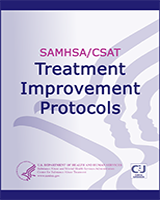NCBI Bookshelf. A service of the National Library of Medicine, National Institutes of Health.
This TIP spells out a strategy for diverting youth with substance abuse problems from further penetration into the juvenile justice system. Members of the consensus panel have defined a process for communities to use in building new linkages and partnerships among treatment programs, community health and social services, and the juvenile court to plan juvenile alcohol and other drug (AOD) diversion programs. All of these collaborators take part in designing the diversion program in which the juvenile justice system and the AOD field are equal partners. They collaborate with many community representatives, who work together to confront the problems presented by juvenile offenders with AOD problems.
Contents
- What Is a TIP?
- Consensus Panel
- Foreword
- Chapter1—Introduction
- Chapter 2 -- Goals of AOD Treatment-Focused Diversion Programs
- Chapter 3—Collaborating on a Diversion Program
- Chapter 4—Planning Juvenile Diversion to AOD Abuse Treatment
- Chapter 5 -- Program Implementation Issues
- Appendix A -- Bibliography
- Appendix B -- Glossary
- Appendix C—CSAT Juvenile Justice Treatment Planning Chart
- Appendix D—Oregon's Department of Human Services Multiagency Release
- Appendix E—Assessment Instruments for Adolescent Populations
- Appendix F—Desktop Guide to Good Juvenile Probation Practice (Legal Rights of Juvenile Offenders)
- Appendix G - "Multicultural Awareness: Developing Cultural Understanding in the Juvenile Justice System[1]
- Appendix H—Prospectus for a Consensus Development Panel
- Appendix I—Federal Resource Panel
- Appendix J—Field Reviewers
This publication is part of the Substance Abuse Prevention and Treatment Block Grant technical assistance program. This publication was written under contract number ADM 270-91-0007 from the Center for Substance Abuse Treatment of the Substance Abuse and Mental Health Services Administration (SAMHSA). Sandra Clunies, MS, served as the CSAT Government project officer. Robert A Lubran, MS, MPA, was the Government content advisor. Carolyn Davis, Constance Gartner, Randi Henderson, Lise Markl, and Gail Martin served as writers.
The opinions expressed herein are the views of the consensus panel members and do not reflect the official position of CSAT or any other part of the U.S. Department of Health and Human Services (DHHS). No official support or endorsement of CSAT or DHHS for these opinions or for particular instruments or software that may be described in this document is intended or should be inferred. The guidelines proffered in this document should not be considered as substitutes for individualized patient care and treatment decisions.
- NLM CatalogRelated NLM Catalog Entries
- Responding to the mental health and substance abuse needs of youth in the juvenile justice system: Ohio's Behavioral Health/Juvenile Justice Initiative.[Am J Orthopsychiatry. 2015]Responding to the mental health and substance abuse needs of youth in the juvenile justice system: Ohio's Behavioral Health/Juvenile Justice Initiative.Kretschmar JM, Butcher F, Kanary PJ, Devens R. Am J Orthopsychiatry. 2015 Nov; 85(6):515-21.
- Diverting multi-problem youth from juvenile justice: investigating the importance of community influence on placement and recidivism.[Behav Sci Law. 2007]Diverting multi-problem youth from juvenile justice: investigating the importance of community influence on placement and recidivism.Hamilton ZK, Sullivan CJ, Veysey BM, Grillo M. Behav Sci Law. 2007; 25(1):137-58.
- Program use of effective drug abuse treatment practices for juvenile offenders.[J Subst Abuse Treat. 2007]Program use of effective drug abuse treatment practices for juvenile offenders.Henderson CE, Young DW, Jainchill N, Hawke J, Farkas S, Davis RM. J Subst Abuse Treat. 2007 Apr; 32(3):279-90. Epub 2007 Mar 9.
- Review The Tuberculosis Epidemic: Legal and Ethical Issues for Alcohol and Other Drug Treatment Providers[ 1995]Review The Tuberculosis Epidemic: Legal and Ethical Issues for Alcohol and Other Drug Treatment ProvidersCenter for Substance Abuse Treatment. 1995
- Review Forensic aspects of juvenile violence.[Child Adolesc Psychiatr Clin N...]Review Forensic aspects of juvenile violence.Haller LH. Child Adolesc Psychiatr Clin N Am. 2000 Oct; 9(4):859-81.
- Combining Alcohol and Other Drug Abuse Treatment With Diversion for Juveniles in...Combining Alcohol and Other Drug Abuse Treatment With Diversion for Juveniles in the Justice System
Your browsing activity is empty.
Activity recording is turned off.
See more...
